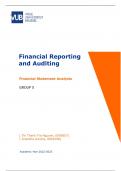Case uitwerking
Financial Reporting and Auditing Assignment - Annual Financial Statement Analysis
- Instelling
- Vrije Universiteit Brussel (VUB)
This is my analysis of the annual statements from AGFA and its competitor KODAK. This is an essential assignment in the Financial Reporting and Auditing course which accounts for 25% of the final evaluation.
[Meer zien]



